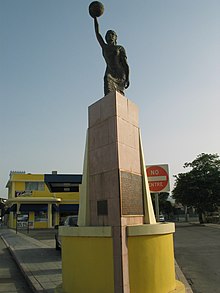 Monumento a la Mujer Monument to Women | |
| Total population | |
|---|---|
| 1,940,618 (females)[1] | |
| Languages | |
| Spanish and English | |
| Religion | |
| Predominantly Roman Catholic, Protestant | |
| Related ethnic groups | |
| Europeans, Africans, Taínos, Criollos, Mestizos, Mulattos |
The recorded history of Puerto Rican women can trace its roots back to the era of the Taíno, the indigenous people of the Caribbean, who inhabited the island that they called Boriken before the arrival of Spaniards. During the Spanish colonization the cultures and customs of the Taíno, Spanish, African and women from non-Hispanic European countries blended into what became the culture and customs of Puerto Rico.
In the early part of the 19th century the women in Puerto Rico were Spanish subjects and had few individual rights. Those who belonged to the upper class of the Spanish ruling society had better educational opportunities than those who did not. However, there were many women who were already active participants in the labor movement and in the agricultural economy of the island.[2]
After Puerto Rico was ceded to the United States in 1898 as a result of the Spanish–American War, women once again played an integral role in Puerto Rican society by contributing to the establishment of the University of Puerto Rico, women's suffrage, women's rights, civil rights, and to the military of the United States.
During the period of industrialization of the 1950s, many women in Puerto Rico found employment in the needle industry, working as seamstresses in garment factories.[2] Many Puerto Rican families also migrated to the United States in the 1950s.
According to the Supreme Court of Puerto Rico, women who are born to Puerto Rican parents in the United States or elsewhere, are considered to be Puerto Rican citizens. On November 18, 1997, the Supreme Court of Puerto Rico, through its ruling in Miriam J. Ramirez de Ferrer v. Juan Mari Brás, reaffirmed the standing existence of the Puerto Rican citizenship.[3] Since 2007, the Government of Puerto Rico has been issuing "Certificates of Puerto Rican Citizenship" to anyone born in Puerto Rico or to anyone born outside of Puerto Rico with at least one parent who was born in Puerto Rico.[4]
Currently, women in Puerto Rico and outside of Puerto Rico have become active participants in the political and social landscape in both, their homeland and in the continental United States. Many of them are involved in the fields that were once limited to the male population and have thus, become influential leaders in their fields.
- ^ 2010 US Census
- ^ a b "Introduction, Puerto Rican Labor Movement", Retrieved October 3, 2013
- ^ Ley Orgánica Foraker del 12 de Abril de 1900 (Spanish). LexJuris
- ^ Enrique Acosta Pumarejo. "La eficacia y alcance del Certificado de Ciudadanía Puertorriqueña". Microjuris. August 30, 2013. Retrieved September 27, 2013.
© MMXXIII Rich X Search. We shall prevail. All rights reserved. Rich X Search
